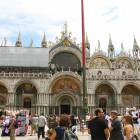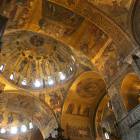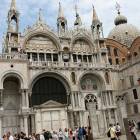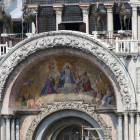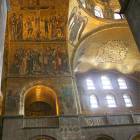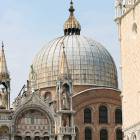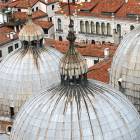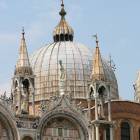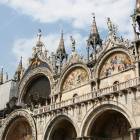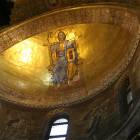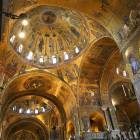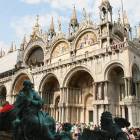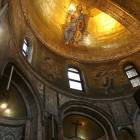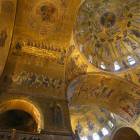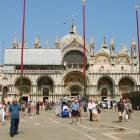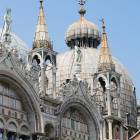The golden Basilica San Marco in Venice
St Mark’s cathedral is the most precious building in Venice, in front of which lays the famous plaza, where all tourists meet. It is connected with the other representative construction on the lagoon, Doge’s Palace, for which it once functioned as a private chapel.
The golden interior of this cathedral is simply breathtaking. The 8.000 square meters of mosaic retell almost all episodes of the Bible in color and precious stones. In the thousand years in which it was built, rebuilt and redecorated, some of the leading painters contributed with drawings for these mosaics: Paolo Veronese, Jacopo and Domenico Tintoretto, Titian and others.
The scenes from the Old Testament are present in the narthex, the space before the main nave, while the New Testament is presented in the main interior space. The style is Byzantine and much of interior makes you think you are in a Greek Orthodox church. That is because the decay of the Eastern Roman Empire was felt last in the Italian towns across the Adriatic Sea, where many craftsmen and artists took refuge, creating conditions for the Renaissance that was to come. Also, away from the threat of being converted into mosques, the churches in Venice, Ravenna or Sicily remained the most faithful and masterful examples of Byzantine art.
The shape itself of this basilica is a Greek cross, with a large dome with the image of Christ Pantocrator, and other smaller domes, connected to it. The models are two creations of emperor Justinian in Constantinople: the Basilica of the Apostles and Hagia Sophia.
When imitation didn’t seem like enough, certain art objects were simply looted from Constantinople to adorn the facade or interior of St Mark’s. That is the case with the four horses that were once pulling a quadriga on a monument in Costantinople, or the Tetrarchs, the statue of the four rulers of the Roman Empire. The quadriga is a cart in which ancient gods were riding, especially Apollo, and monuments like these are usually present during times when the pagan heritage was reconsidered. Other art objects, like the famous Pala D’Oro, the altarpiece of gold and enamel icons, were not stolen but commissioned to artists in the capital or Byzantium.
Even the relics of the Evangelist, who gave the name of this cathedral and became patron of Venice, got here because they were stolen from Jerusalem. Saint relics became objects of traffic in the Middle Ages, but of course, the authenticity of such a distant Biblical character remains is highly questionable. The lion, the symbolic animal that tradition associates with Mark the Evangelist, became the symbol of the city, present everywhere, including on the facade. Also the highest statue on the facade is that of Saint Mark.
The facade is one of the most important elements that is not in tone with the Byzantine tradition. It is a Gothic facade, but it too displays some important Byzantine mosaics from the life of Christ. The terrace on the facade is accessible for tourists, who can get a panoramic view over San Marco Square, over the Doge’s Palace or the nearby canals. The three flag poles and the bell tower (campanile) sit in front of it.
Mai multe despre: Italia, Religious architecture • Byzantine art • Byzantine mosaic • gothic architecture • Italy • mosaic • Saint Mark • San Marco • Venezia • Venice- Home Page
start page - Architecture
landmark buildings - Sacred architecture
places of worship - Nature
landscape photography - Concert
performing artists - Christmas
Santa Claus pictures
- Jooble
jobs for photographers - Escape
an out of control blog - Merry Christmas
The best organizer of Christmas parties - Astro photo
Eclipse hunting and astrological photography



